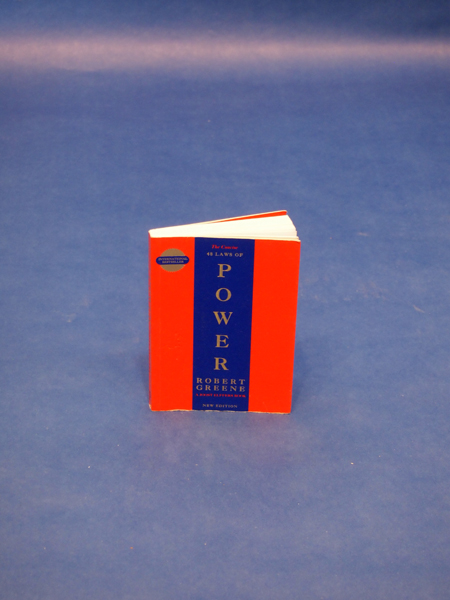![]() body | color | collections | commodity | cube | document | fabric | fetish | gender | glass | home | identity | living | machine | metal | minimal | mobility | narrative | olfactory | organic |
body | color | collections | commodity | cube | document | fabric | fetish | gender | glass | home | identity | living | machine | metal | minimal | mobility | narrative | olfactory | organic |
![]() pain | paper | plastic | plugs | power | protective | rectangular | ritual | round | sound | souvenir | spiritual | style | text-based | time | tool | touch | uniform | value | visual | warm | wood
pain | paper | plastic | plugs | power | protective | rectangular | ritual | round | sound | souvenir | spiritual | style | text-based | time | tool | touch | uniform | value | visual | warm | wood
| Book: The Concise 48 Laws of Power | |||
Narrative: The Concise 48 Laws of Power Text for The Concise 48 Laws of Power was typeset and the mechanical copy of the manuscript was sent to a printer. The vendor then photographed the pages to produce page negatives. Next, negatives were stripped by hand onto large flat sheets known as 'goldenrods,' and the goldenrods were exposed with ultraviolet light. This resulted in 'blueprints," a positive reproduction of the book that is then checked for accuracy. The paper was made from pulp obtained by chemical means, known as kraft pulping. Chips of wood were placed in a large, sealed container known as a digester. The digester contained a strongly alkaline solution of sodium hydroxide and sodium sulfide. The mixture was heated to 320-356° F (160-180°C) at a pressure of about 116 pounds per square inch (800 kilopascals). Bleaching removes lignin and involves mixing the pulp with a series of oxidizing chemicals that react with the lignin. After each mixture, the pulp is washed with an alkaline solution that removes the treated lignin. Fillers are added to the pulp. A typical filler is a clay known as kaolin. Other chemicals often added to pulp include starches or gums. Rosin (a substance derived from pine trees) and alum (aluminum sulfate) are often added as sizers, making the paper less absorbent. Pulp is added to water to form slurry in order to make paper with an even density. The slurry is pumped onto a moving mesh screen made up of very fine wires of metal or plastic. Water drains through the small openings in the mesh, forming a sheet of wet material from the slurry. After the typeset version of the book was reviewed and necessary changes made, it was printed and bound with the cover, resulting in a finished book. The typesetting and printing consists of filming and all subsequent steps are typically done by specialized vendors. Book binding also involves sewing the signatures together, gluing the spine, and inserting lining and trimming the edges. Finally the book is enclosed in a cover. I purchased this book in the airport in Dubai, the only book in English that wasn't a mystery novel. A few years prior I had seen this book everywhere: from the subway to the street to window displays and a friend's apartment who claimed a connection to the author. I ended up skimming through it on the plane. |
 |
||
![]()
